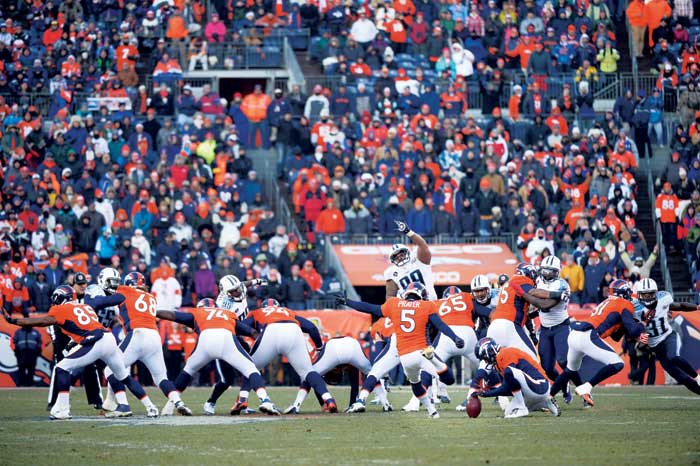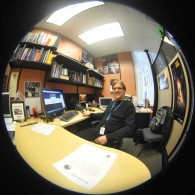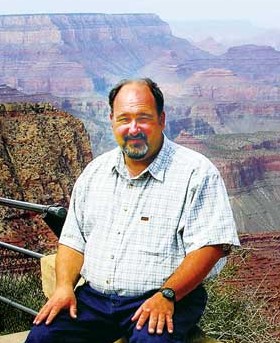
Matt Prater is just about to deliver his historic 64-yard kick. Photo by Joe Amon/The Denver Post.
Coloradans have a new record to celebrate—the NFL’s longest field goal. In a bone-chilling game against the Titans, the Broncos’ Matt Prater kicked a 64-yarder, breaking one of the NFL’s most iconic records. News of this accomplishment buzzed across the nation—even giving non-football fanatics something to admire. Yet many grumbled or belittled the accomplishment.
High altitude was invoked, suggesting the kick went farther than normal due to the less-dense Denver air. Others suggested that the cold temperatures made the air more dense, offsetting high-altitude effects. Such post-game rhetoric is common, but most of it is speculative. Let’s examine how much these factors actually matter.
Bob Beamon’s mindblowing long jump at the 1968 Mexico City Olympics produced similar speculation about whether altitude helped him earn the world record. In contrast to previous long-jump records, which were broken in incremental inch-wise increases, Beamon extended the previous mark by nearly two feet! His jump was so long that judges repeatedly measured its distance because the stadium’s automated system wasn’t capable of measuring such a length. Perhaps they were also shocked! Beamon’s effort, together with 13 other records set at that Olympics, were both celebrated and panned. Like the Denver field goal, critics suggested that Mexico City’s 7,350-ft. elevation made the record jump easier to attain.
The less-dense-air logic stems from high-elevation cities having less atmosphere above them. Although primarily composed of light gases, the atmosphere weighs enough that it pushes downward on the gases below it, creating atmospheric pressure. The thicker the atmosphere above a city, the more the air on the surface is compressed, making it denser.
In order for a runner, jumper or ball to move, it must displace or move air out of the way. Denser air requires more energy to move out of the way, thus providing more resistance to the person or object moving through it. Thus, in high-elevation cities where the air is less dense, athletes expend less energy moving air out of the way and encounter less resistance. The net result is that a greater proportion of their energy goes toward running fast, jumping far and kicking hard.

Dimitri I. Klebe
In principle, this makes sense. Yet in practice, it doesn’t always agree with the data. For example, most of the other record-setting Mexico Olympians only incrementally eclipsed previous records, and athletes who jumped before Beamon did not achieve personal bests in their jumps. That’s odd—why weren’t they all shattering their personal bests?
It wasn’t until 18 years later that an engineer figured it out by quantifying the environmental factors that assisted or inhibited Beamon’s jump. He determined that Mexico City’s less-dense air allowed Beamon to jump about six inches farther. A tailwind doubled that amount. Yet more than nine inches of the jump cannot be explained by “favorable” or “easier” environmental conditions—suggesting nothing less than outstanding athletic performance.

Daniel Winester
How did Denver’s thin air impact Matt Prater’s record-breaking kick? Did other environmental conditions, such as cold air or wind, assist or inhibit the kick? To address these questions, we analyzed Prater’s kick, other top NFL and NCAA field goal kicks, and the environmental conditions in which they occurred. After constructing an environmental kick model, we analyzed what might happen if Prater’s kick were to occur under “ideal” environmental conditions—as if the ball was kicked at sea level on a warm but not excessively humid, dry or windy day.
Because the air was somewhat humid during the Broncos game, we first examined humidity effects. After all, the previous record-setting field goal occurred in New Orleans nearly 43 years prior, in what was described as “soupy, thick humid air.” Yet when we modeled the effects of humidity on Prater’s kick, we were surprised that it actually could have added an eighth of an inch to the kick’s distance.
What? Wouldn’t high humidity inhibit the ball’s movement through the air? Humid air sure seems harder to breathe. Counterintuitively, humid air is less dense than dry air, because the relatively heavy nitrogen and oxygen molecules that make up the bulk of our air get displaced by lighter water vapor molecules. More light stuff in air equals less dense air. This explains the humidity assist. Overall, humidity’s impact on impeding a moving football is small. Even the muggiest New Orleans air can only boost a kick by about 10 inches.
The biggest impacts on air density are atmospheric pressure and temperature. For Prater’s kick, the low air pressure due to Denver’s elevation allowed the football to travel more than six and a quarter yards farther than it might have at sea level. Yet because cold air is more dense than warm air, subfreezing temperatures retarded the ball’s travel by nearly three and a half yards.
In the same way that air density decreases with increasing elevation, the earth’s gravity is often reduced at higher elevations. In principle, Prater’s kick should have had a reduced downward tug upon it in Denver’s high elevation, and been able to travel farther. But latitude plays a larger role, and compared to more southern stadiums like the one in New Orleans, Denver has increased local gravitational conditions. Colorado’s gravity thus accelerates the movement of a football downward faster, resulting in a decrease in the distance of a kick. Fortunately, gravitational variations only have a small impact, potentially reducing Prater’s kick distance by less than a quarter inch.
What about wind? A modest breeze flapped the goalpost flags during Prater’s kick. Given the air density and kick trajectory, this tailwind had the biggest impact of all—potentially contributing almost five yards of extra distance to the field goal. But considering how quickly winds and vortices can shift in a bowl-shaped stadium like Denver’s, it’s possible that the wind lulled a bit while the kick was in the air. Even with such a slowing, the baseline wind conditions would still have added at least one and a half yards to the kick distance.
Considered together, Denver’s wind and air conditions allowed this kick to travel between four and a half to eight yards farther than it might have in “ideal” sea level conditions.
Is this the whole story? Nope. We haven’t considered the ball yet. Its spin and wobble affects its ability to move through air. Spiraling footballs deftly slice the air at 80 mph, but wobblers move like gridiron tumbleweeds. What about temperature? Try kicking a frozen football. Its lower elasticity makes it behave more like a rock, impeding transfer of energy from a kicker’s leg to the ball, and altering the ball’s recoil behavior. This might negate some or all of the yardage advantages we calculated from wind, gravity and air effects.
Although our analysis isn’t yet complete, a 64-yard field goal is still an amazing feat. We hope these initial results are thought-provoking. In the meantime, we’re proud of Matt Prater and all his Broncos teammates. We admire what it took to kick a ball 64 yards (actually, 64.2 yards!) in frigid conditions. And, we look forward to hearing about the next world record—hopefully to be set when the Broncos are in Super Bowl XLVIII!
James W. Hagadorn, Dimitri I. Klebe and Daniel Winester collaborated to produce this work. Suggestions and comments are welcome at jwhagadorn@dmns.org.



0 Comments